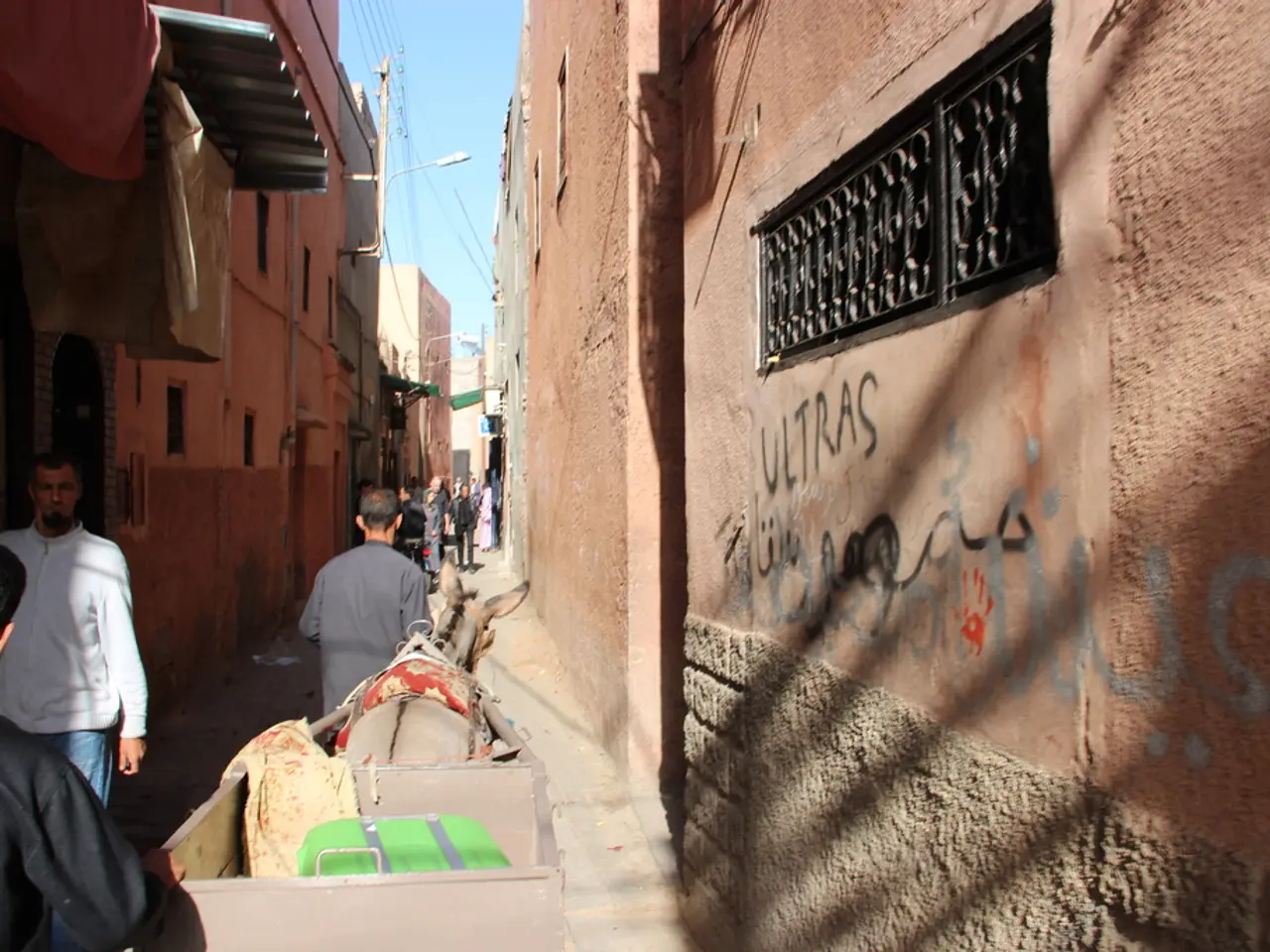Humanitarian aid airlifts in Gaza under scrutiny for inadequacy, high cost, and risk to the populace, as stated by humanitarian organizations
In the embattled Gaza Strip, the delivery of essential aid has become a contentious issue. While airdrops offer a means to deliver vital supplies quickly, they are far from an ideal solution, posing significant risks and inefficiencies.
The danger posed by airdrops to the population is a growing concern. Incidents in the past have resulted in casualties, with a recent example being the unfortunate death of a nurse who was killed when an aid pallet fell on him during a drop [1][4]. Humanitarian organizations have raised serious concerns about the method of delivering aid by airdrops, citing safety risks, inefficiency, and limited aid volume as key issues [1][2][4].
Airdrops are expensive, delivering less aid compared to trucks, and are considered much less effective than land deliveries through crossings. They often do not reach the most vulnerable because recipients are too weak to compete for the aid, and the distribution is uneven. Sometimes aid lands in the sea or inaccessible areas [1][2][4].
Despite these challenges, aerial drops have resumed in the region. The Israeli government, under a tactical pause in hostilities, has allowed for humanitarian aid to be delivered [3]. However, the Israeli government's blocking of aid entering Gaza while allowing aerial drops is seen as cynical by some, as there is no evidence to support their claims that humanitarian aid is being diverted for military purposes [5].
On the other hand, allowing trucks to pass can ensure the coordinated and secure delivery of medicines to health centers, as well as other essential food items such as wheat flour for bakeries, nutritional products for children, and medical supplies [2]. Humanitarian officials view land deliveries as crucial to delivering sufficient and safe assistance to Gaza’s population. Aid by land allows much larger volumes to be delivered and better distributed [1][2].
However, even when aid convoys enter by land, they face delays, hazards, and limited quantities due to restricted access through crossings [1]. Tensions among starving and desperate people trying to retrieve aid have led to the potential formation of new gangs and a war economy [6]. The principle of humanitarian aid is to distribute it as equitably as possible to the most vulnerable populations, such as women, children, and the elderly [7].
The Gaza Strip has been under a total and absolute blockade by the Israeli army since March 2025. More than a third of the population in the Gaza Strip goes several days without eating, and a quarter of the population lives in conditions close to famine [8][9]. In the absence of law and order, people can make money off the population [10].
In an effort to alleviate the crisis, France has announced a 40-ton aid drop for starving populations in the Gaza Strip [11]. The United Kingdom and Belgium have also declared their intention to carry out similar operations [12]. However, the international community continues to stress the importance of opening secure land routes to ensure safe, sufficient, and equitable humanitarian aid delivery to the Gaza Strip [1][2][3][4].
References:
[1] Al Jazeera. (2021, August 10). Gaza aid crisis: The high cost of a blockade. Retrieved from https://www.aljazeera.com/news/2021/8/10/gaza-aid-crisis-the-high-cost-of-a-blockade
[2] Human Rights Watch. (2021, August 10). Gaza: Aid by air, not by force. Retrieved from https://www.hrw.org/news/2021/8/10/gaza-aid-air-not-force
[3] Middle East Monitor. (2021, August 10). Israel declares tactical pause in Gaza hostilities to allow aid into territory. Retrieved from https://www.middleeastmonitor.com/20210810-israel-declares-tactical-pause-in-gaza-hostilities-to-allow-aid-into-territory/
[4] The New Humanitarian. (2021, August 10). Gaza: Aid drop kills nurse, raises safety concerns. Retrieved from https://www.thenewhumanitarian.org/news-feature/2021/08/10/Gaza-aid-drop-kills-nurse-raises-safety-concerns
[5] The Palestine Chronicle. (2021, August 10). Israel accused of cynicism for allowing aid drops while blocking land entry. Retrieved from https://www.palestinechronicle.com/israel-accused-of-cynicism-for-allowing-aid-drops-while-blocking-land-entry/
[6] The Guardian. (2021, August 10). Gaza aid crisis: Tensions among Palestinians risk formation of new gangs and war economy. Retrieved from https://www.theguardian.com/world/2021/aug/10/gaza-aid-crisis-tensions-among-palestinians-risk-formation-of-new-gangs-and-war-economy
[7] Médecins Sans Frontières (MSF). (2021, August 10). Gaza: MSF warns of the dangers of the aid crisis. Retrieved from https://www.msf.org/gaza-msf-warns-of-the-dangers-of-the-aid-crisis
[8] United Nations Office for the Coordination of Humanitarian Affairs (OCHA). (2021, August 10). Gaza Strip: Humanitarian Situation. Retrieved from https://www.ochaopt.org/content/gaza-strip-humanitarian-situation
[9] World Food Programme. (2021, August 10). Gaza Strip. Retrieved from https://www.wfp.org/emergencies/gaza-strip
[10] The Washington Post. (2021, August 10). Gaza aid crisis: In the absence of law and order, people make money off the population. Retrieved from https://www.washingtonpost.com/world/2021/08/10/gaza-aid-crisis-in-absence-law-and-order-people-make-money-off-population/
[11] France 24. (2021, August 10). France to airdrop 40 tons of aid to Gaza Strip. Retrieved from https://www.france24.com/en/live-news/20210810-france-to-airdrop-40-tons-of-aid-to-gaza-strip
[12] The Brussels Times. (2021, August 10). Belgium and UK to airdrop aid to Gaza Strip. Retrieved from https://www.brusselstimes.com/news/world/124056/belgium-and-uk-to-airdrop-aid-to-gaza-strip/
- The international community is emphasizing the significance of secure land routes for the delivery of humanitarian aid in Gaza, arguing that it ensures safer, sufficient, and more equitable distribution compared to airdrops.
- Despite France, the United Kingdom, and Belgium planning to drop aid in the Gaza Strip, humanitarian organizations continue to advocate for the reopening of land routes, stating that aerial drops pose risks, inefficiencies, and limited aid volume.







